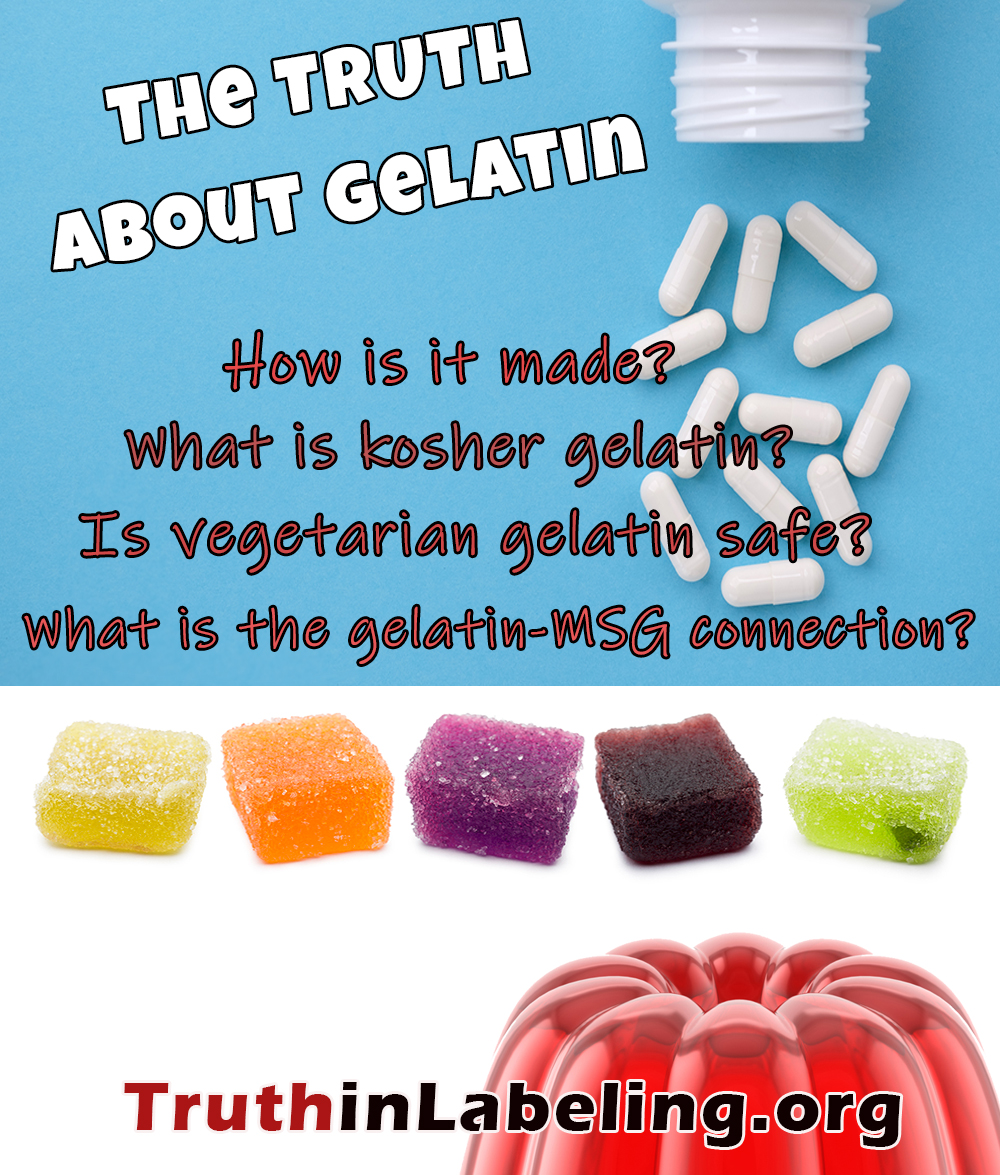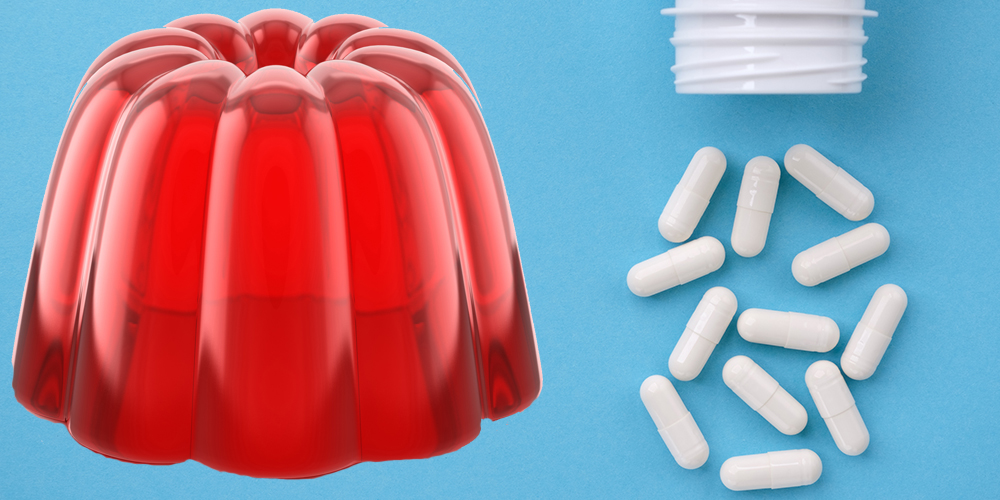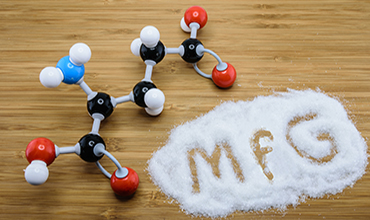The Truth about Gelatin originally appeared in Earth Clinic a top-rated alternative health website that features in-depth information and videos about holistic treatments (for both people and pets), home remedies and effective health-boosting uses for numerous everyday products ranging from coconut oil to hydrogen peroxide.
By Adrienne Samuels
You’re likely to run into gelatin in some surprising places. While it’s commonly found in foods such as gelatin desserts (think Jell-O), aspic, marshmallows, gummy candies, vitamins, and other supplements (including pill capsules), it can also turn up used as a binder in yogurt, ice cream, cream cheese and anywhere a food manufacturer wants to create a good “mouthfeel” for their product.
But like sausages, nobody wants to see how gelatin is made.
Most of the gelatin found in food and supplements comes from heat-degraded collagen derived from pigs and cows. It’s an ugly process that completes the cruel loop of factory farming by taking bone, stripped skin, and connective tissue from slaughterhouses and processing them (through acid, heat, and grinding) into an innocuous-looking, tasteless powder.
There’s nothing in that bouncy gelatin dessert or a smiling gummy bear that will give a hint of the cruelty involved in its creation. But ethical concerns aside, there’s much more not to like about gelatin.
The Gelatin – MSG Connection
Although it might seem that a marshmallow Peep has nothing in common with a shaker of the MSG flavor-enhancer Accent, they are actually related as both contain manufactured free glutamate.
Just as drugs have side effects, manufactured free glutamate has side effects such as irritable bowel, headache, heart irregularities, and skin rash. In addition, manufactured free glutamate is an excitotoxin: a neurologically active compound that in high concentrations has detrimental excitatory effects on the central nervous system and may cause injury to nerve cells.
Manufactured free glutamate is created in food ingredients when protein is broken down into its constituent amino acids. One of those amino acids will always be free glutamate. It is also mass-produced using genetically modified bacteria that excrete glutamate through their cell walls.
In the case of gelatin, the Encyclopedia of Food Science and Technology states that glutamic acid (a.k.a. glutamate) which makes up around 10 percent of gelatin, isn’t the only neurotoxic component released during the manufacturing process. Aspartic acid, another brain-damaging amino acid is also present at a level of around 6 percent. Both sources will cause the same adverse reactions in people, and according to experts like Dr. John Olney, both glutamic and aspartic acid will combine to produce a toxic double-whammy.
Might you have a noticeable reaction to a gelatin product? That would depend on your individual sensitivity as well as the amount of manufactured free glutamate you consume in foods along with the gelatin. And your sensitivity is something that can change with age, illness, if you suffer a head injury, or consume a large amount of manufactured free glutamate.

Don’t Ask, Don’t Tell
Look at any gelatin-containing product in the store and you won’t see any mention whatsoever of glutamic acid, aspartic acid (or pigskin and tendons being bathed in acid for that matter). But beyond packaging, which fails to disclose important information about the possible toxic effects of gelatin, are the lies circulated by Big Food to convince you to buy their products.
You’ll hear that manufactured free glutamate is “naturally occurring,” has been extensively studied and found to be “safe,” and the biggest whopper of all — that the glutamate in the human body is exactly the same as what you’ll find in foods such as gelatin. The real story is that all manufactured free glutamate contains impurities that are unavoidable by-products of the manufacturing process.
But what about “kosher” or even “vegetarian” gelatin, are those better choices?
A Fishy Proposition
Kosher gelatin can be derived from either fish or cows certified as kosher and killed in a specific manner. Since kosher rules prohibit the combining of meat and dairy, if you notice kosher gelatin in a dairy product, it’s probably fish-derived.
Fish byproducts such as skin, scales and bones contain high amounts of collagen, and the processing will release neurotoxic free glutamate just as with gelatin from cows or pigs. Published research out of Indonesia has found free glutamic acid amounts in fishbone gelatin ranging from a low of over seven percent to a high of over 10 percent, with aspartic acid going from a low of close to five percent to a high of 6.5 percent, depending on the type of fish.
Vegetable Gelatin
As far as veggie gelatin goes, it too has issues.
Produced from processed algae and seaweed (a marine algae), vegetarian gelatins are derived from rich sources of certain amino acids that will also contain significant amounts of free glutamate and aspartic acid after processing.
If gelatin is something you’ve decided to avoid, it pays to read the ingredient labels of all processed foods and supplements thoroughly, as well as pharmaceuticals (including OTC drugs). And while you won’t be able to determine if the gelatin came from pigs, cows, or fish, the name gelatin is required to be listed on the packaging.
Resources:
The Free Dictionary: https://medical-dictionary.thefreedictionary.com/excitotoxin (accessed 5/4/21)
Amino acid and proximate composition of fish bone gelatin from different warm-water species: A comparative study.
https://iopscience.iop.org/article/10.1088/1755-1315/58/1/012008 (accessed 5/4/21)





